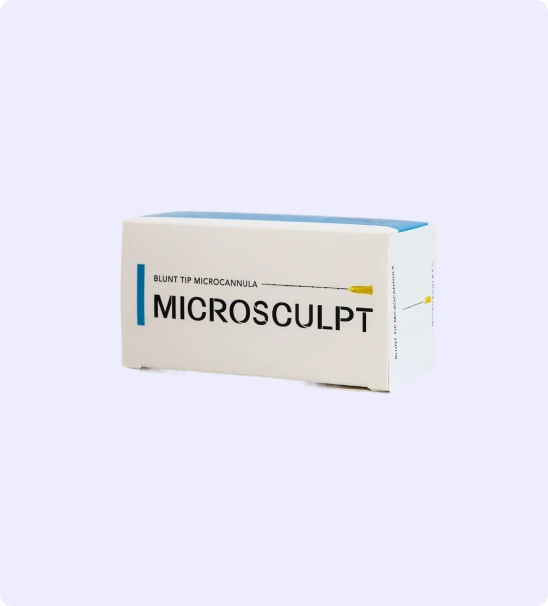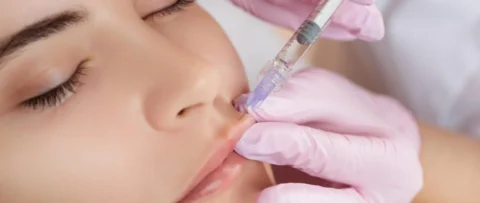Dermal filler injection has rapidly become a favorite of both patients and dermatologists for facial rejuvenation treatments. Less painful than laser ablation and with longer-lasting results, facial injectables like hyaluronic acid are effective ways to address the signs of aging and other skin-related disorders. With the introduction of the blunt tipped cannula, dermal filler treatments are now more comfortable and accessible to patients and aestheticians alike.
But why is a cannula needle for fillers better than a sharp tipped needle? The cannula technique reduces the trauma experienced by the patient during dermal filler treatments, reduces the likelihood that complications like vascular occlusion from occurring during the injection, and gives the injector more freedom and control over the filler material.

Injections Your Patients Will Love! Code “20OFF” Takes 20% off Your First Order!
Microcannulas are a tool that every great injector must master. Patients want quick results with no downtime. Our microcannulas are high quality and a fraction of the price of our competitors!
You can create an account here.
How A Blunt Cannula Works
The injection technique for a blunt cannula differs from traditional needle injection in several ways:
- Single entry points: Unlike a hypodermic needle, a single injection site can be used by a cannula for multiple injectable filler applications
- Less force required: Cannulae give more feedback to the injector during insertion, allowing them to properly “feel” their way underneath the dermal layer
- More flexible: Most micro cannulas used for filler treatment have a flexible shaft, allowing the cannula injection to reach more areas under the skin
The biggest difference that allows the micro cannula to shine better than a hypodermic needle is in the design of the tip. The needle technique relies on the beveled edge of the needle tip to penetrate the surface of the skin and the subdermal layers below. While this requires less force compared to the cannula technique, it also increases the risk of passing through a blood vessel, which can lead to complications like occlusion or accidental intravascular injection of the dermal filler.
Blunt cannulas avoid this complication by pushing rather than piercing their way during a dermal filler injection. This small yet significant change to the injection technique allows a skilled injector to apply dermal filler without causing their patient any stress and reducing common side-effects from dermal filler treatments like bruising, bleeding, or discoloration.
How To Properly Use A Micro Cannula For Dermal Filler Treatments
Admittedly, the cannula technique requires more experience compared to using a hypodermic needle – which is why this technique isn’t standard for facial injectables. But given that there are some injectable filler brands like Restylane that work better with microcannulas than needles, developing an understanding of the cannula technique is necessary for dermatologists and aestheticians today.
Do not apply too much force to the blunt tip cannula
One mistake that many first-time users of a micro cannula make is applying too much force during the injection. This usually occurs because of overcompensation for the smooth penetrating action of a sharp tip needle. While more initial force is required to inject a cannula underneath the skin, applying too much force may stress the shaft and cause it to snap, or push the cannula to unintentional places.
This is particularly crucial with deep dermal filler injection treatments that target areas like the nasolabial fold. Because of its proximity to areas like the eyes, lip augmentation using cannulas should always be handled with some degree of delicacy from the injector. Otherwise, they risk making contact with the periosteum of the patient, which can cause them significant discomfort.
Keep in mind the rheology of your dermal filler
The flow rate of filler treatment isn’t universal – because of the different brands and their active ingredients, the rheology of the dermal filler should always be accounted for with cannula use. This is especially important for soft tissue fillers that rely on a steady flow rate through the needle for even results, or for processes like lip augmentation that call for specialized filler material.
A dermatologist should always make sure that their microcannula injections account for the flow of their facial filler through the needle before application to a patient. Failure to account for this process can result in uneven distribution of filler material or distortions in the patient’s visible results.
Pay attention to the feedback from the cannula
The blunt tip cannula offers a unique advantage over the sharp tip needle with the feedback that the injector can get from the needle injection process. Careful attention to the resistance offered by the patient’s facial structure can help them gauge where and how much filler material needs to be added to the injection site, and avoid any significant blood vessel or artery during the process. Additionally, the cannula method can also help them determine the exact amount of pressure required to help the cannula reach further injection sites without hurting the patient.
Because cannulas tend to be longer than traditional needles, the injection technique of a blunt tipped cannula relies on how well the injector understands the facial anatomy of their patient and the interaction the facial filler has with the treatment area. Since microcannula injections only require one entry point, understanding the resistance and interaction the blunt tipped cannula has during the injection is crucial for giving the patient the best results.
The best way for an injector to learn how to use the microcannula properly is to enroll in a course or a program that can certify their use for microcannulas in their practice. Not only does this guarantee that they’ll be able to train themselves in a controlled environment, but it also eases the worry of any prospective patient that they’ll take for microcannula injections.
Get Blunt Microcannulas And Other Medical Supplies From FACE Medical Supply Today
-
 23 gauge 50 mm (2 inch) Microcannulas
23 gauge 50 mm (2 inch) Microcannulas -
 22 Gauge 100 mm (4 inch) Microcannulas.
22 Gauge 100 mm (4 inch) Microcannulas. -
 27 Gauge 38 mm (1.5 inch) Microcannulas
27 Gauge 38 mm (1.5 inch) Microcannulas -
 25 Gauge 38 mm (1.5 inch) Microcannulas
25 Gauge 38 mm (1.5 inch) Microcannulas -
 30 Gauge 25 mm (1 inch) Microcannulas
30 Gauge 25 mm (1 inch) Microcannulas -
 18 Gauge 100 mm (4 inch) Microcannulas
18 Gauge 100 mm (4 inch) Microcannulas -
 25 Gauge 50 mm (2 inch) Microcannulas
25 Gauge 50 mm (2 inch) Microcannulas -
 21 Gauge 50 mm (2 inch) Microcannulas
21 Gauge 50 mm (2 inch) Microcannulas -
 21 Gauge 70 mm (2.75 inch) Microcannulas
21 Gauge 70 mm (2.75 inch) Microcannulas
Microcannula injections are the best option for using facial filler, especially for treating areas like tear trough lines and injecting lip filler. While there are still cases where the sharp tip needle can be effective, the cannula method is an excellent alternative for when needle injection may prove too difficult for the patient’s skin to handle. With the proper technique and a reliable source of micro cannula supplies, an injector can easily master filler treatment and elevate their practice above their competitors.
FACE Medical Supply is a proud partner of cosmetic and medical practices, providing them with high-quality yet affordable medical tools and supplies used in traditional sharp needle treatments and blunt tip cannula procedures. Combined with our extensive inventory and special attention to our customer service, we help our clients keep their practices well-stocked and their services safe and effective.
For more information about us, our services, and the products that we provide, contact us today.








